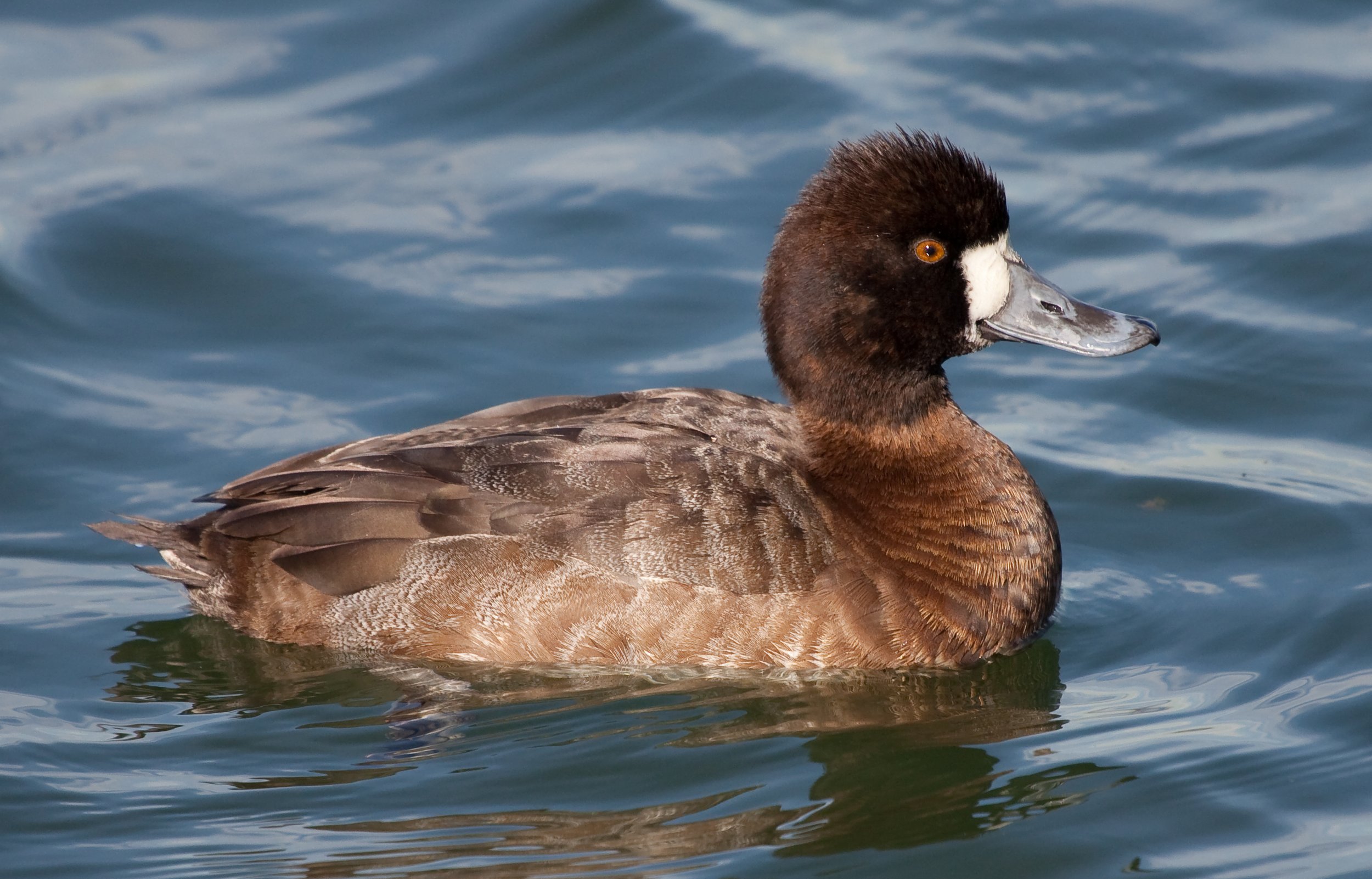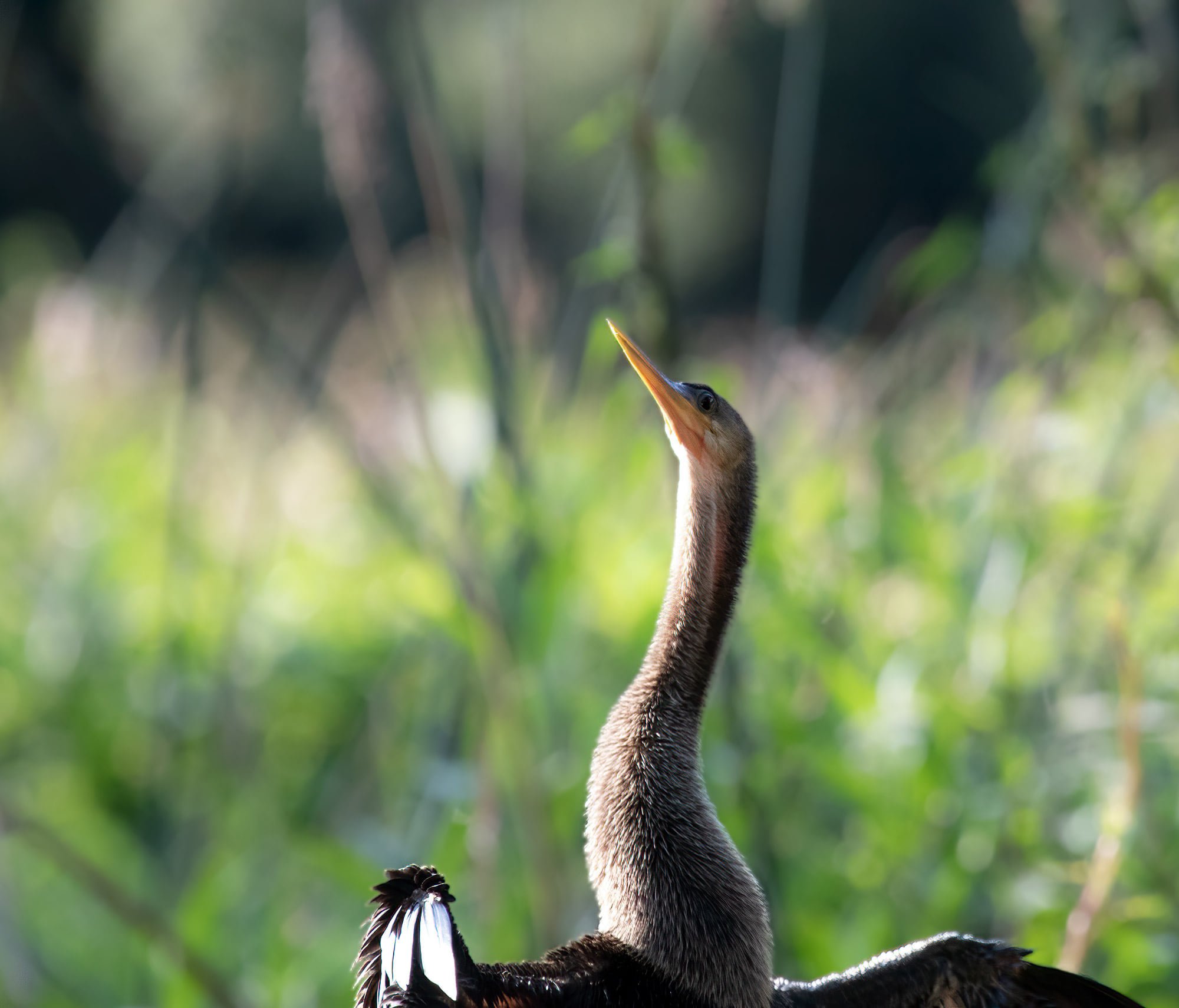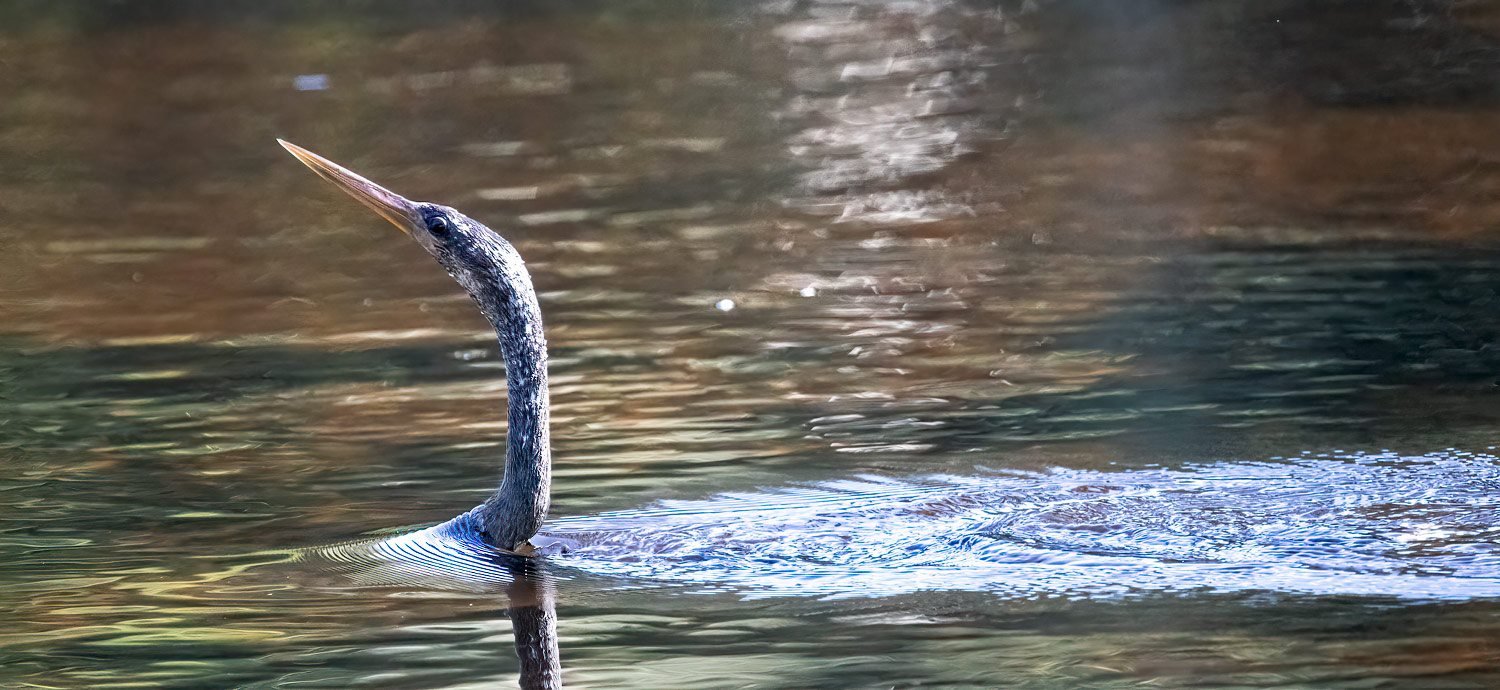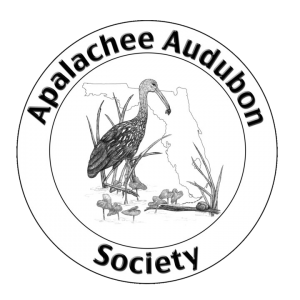June 2024 Bird of the Month
Wood Stork | Mycteria americana
Wood Stork standing on the shore of Lake Elberta Park. Photo by Kathleen Carr
Wood Storks might not win a beautiful bird contest (They do have lovely pink feet!), but we are fortunate to be able to observe this majestic and graceful wading bird at Lake Elberta Park throughout the year. Infrequent visitors, it’s not unusual to see one or two perched on the peninsula sleeping and grooming, or foraging along the edge of the lake. In January 2024, a group of 12 was seen at the park!
They are the only member of the stork family that breeds in North America. Since they are found in a small portion of the southeastern United States, the U.S. Fish and Wildlife Service lists them as federally threatened. Globally, however, the Wood Stork is considered to be of least concern by the International Union for Conservation of Nature, due to its large range across the Caribbean and South America.
Wood Stork parent in nest with three young. Photo by Lorraine Minns, Audubon Photography Awards
May 2024 Bird of the Month
Red-winged Blackbird | Agelaius phoeniceus
Male Red-winged Blackbird displaying its shoulder patches. Photo by Owen Ehrlich/Audubon Photography Awards.
One of the most abundant birds across North America, and in Lake Elberta Park, Red-winged Blackbirds can be seen perching and flying along the edges of the lake. The glossy-black males have scarlet-and-yellow shoulder patches they can puff up or hide depending on how confident they feel. Females are a subdued, streaky brown, almost like a large, dark sparrow.
During the breeding season, where there’s standing water and vegetation, Red-winged Blackbirds are likely to be one of the most common birds you see and hear. Listen for the male’s conk-la-lee call!
Female Red-winged Blackbird Photo by Donald Henderson, Audubon Photography Awards.
Female Red-winged Blackbird feeding its fledgling. Photo by Ken Lassman.
April 2024 Bird of the Month
Eastern Bluebird | Sialia sialis
Male Eastern Bluebird perched in Yaupon Holly. Photo by Steve Herron.
Bluebird nest box at Lake Elberta Park. Photo by Kathleen Carr
Eastern Bluebirds live in open country around trees, but with little understory and sparse ground cover. This small, brightly colored thrush typically perches on wires and fence posts overlooking open fields. Original habitats probably included open, frequently burned pine savannas, beaver ponds, mature but open woods, and forest openings. Today, they’re most common along pastures, agricultural fields, backyards, golf courses, and parks—like Lake Elberta Park. The birds forage by fluttering to the ground to grab an insect, or occasionally by catching an insect in midair.
Bluebirds are reliant on human-built nest boxes due to loss of natural habitat, and that’s why AAS has provided a nestbox at this park.
Female Eastern Bluebird incubating eggs in the Lake Elberta nest box, March 16, 2024. Photo by Kathleen Carr.
March 2024 Bird of the Month
Purple Martin | Progne subis
Male Purple Martin with a freshly captured insect meal. Michael Cohen/Audubon Photography Awards
The largest of the swallows in North America, Purple Martins are known for engaging in aerial acrobatics to snap up flying insects. They arrive at Lake Elberta Park in mid-January, and in March they start nesting in the white gourds on the west side of the lake, near Lake Bradford Rd. After raising up to three clutches of offspring, they leave in mid-July and migrate to South America for the winter.
Adult males are iridescent, dark blue-purple overall with brown-black wings and tail. Females and immatures are duller, with variable amounts of gray on the head and chest and a whitish lower belly.
Native Americans hung up empty gourds for the Purple Martin before Europeans arrived in North America. Purple Martins in eastern North America now nest almost exclusively in birdhouses, but those in the West use mostly natural cavities, such as woodpecker cavities in trees.
Two-minute long video of Purple Martins at Lake Elberta Park, recorded July 12, 2023.
Nestlings in nest gourds and adult/immature birds perched on the gourd array.
February 2024 Bird of the Month
Yellow-rumped Warbler | Setophaga coronata
Photo by Lucas Pittman
Yellow-rumped Warblers are small brownish songbirds with yellow patches on their sides and bright yellow feathers on their rumps, for which they are affectionately referred to as “Butter Butts.” During the winter months, they are the most abundant warbler in Lake Elberta Park and can be see foraging in the grass. They're often perched on the outer limbs of trees and are very conspicuous as they fly out after insects, often making long, aerobatic flights and flashing their yellow rumps and white patches in the tail. In fall and winter, they are found in open woods and shrubby habitats, including coastal vegetation, parks, and residential areas.
COOL FACT: Yellow-rumped Warblers are perhaps the most versatile foragers of all warblers. They're the warbler you're most likely to see fluttering out from a tree to catch a flying insect, and they're also quick to switch over to eating berries in fall. Other places Yellow-rumped Warblers have been spotted foraging include picking at insects on washed-up seaweed at the beach, skimming insects from the surface of rivers and the ocean, picking them out of spiderwebs, and grabbing them off piles of manure.
January 2024 Bird of the Month
Lesser Scaup | Aythya affinis
A group of Lesser Scaup, by Walker Golder, National Audubon Society
The Lesser Scaup is a small North American diving duck that breeds in the NW United States and Canada, then migrates south for the winter. During migration and the winter months, tight-knit groups of Lesser Scaup congregate on large lakes, reservoirs, and estuaries, sometimes by the thousands. At Lake Elberta, it's common to see a flock of a dozen or more floating and feeding.
From afar flocks might just look like floating mats of vegetation on the water. A closer look reveals black-and-white males and chocolatey-brown females floating on the surface and diving below to eat aquatic invertebrates and plants.
COOL FACT: Lesser Scaup spend the winter farther south than any other diving duck in their genus (Aythya)—some go as far south as Central America and the Caribbean.
Male Lesser Scaup, Wikipedia
Female Lesser Scaup, Wikipedia
December 2023 Bird of the Month
Eastern Phoebe | Sayornis phoebe
Eastern Phoebe. Photo by Kent Fiala, Audubon Photography Awards.
From October through April, if you listen as you walk around Lake Elberta, you may hear a call that sounds like “PHEEE-bee”. You just heard an Eastern Phoebe, a common wintering bird in Tallahassee and Lake Elberta Park!
One of our most familiar eastern flycatchers, the Eastern Phoebe’s raspy “phoebe” call is a frequent sound around yards and farms in spring and summer. These brown-and-white songbirds sit upright and wag their tails from prominent, low perches.
Flying insects make up the majority of the Eastern Phoebe’s diet. Common prey include wasps, beetles, dragonflies, butterflies and moths, flies, midges, and cicadas; they also eat spiders, ticks, and millipedes, as well as occasional small fruits or seeds.
They typically place their mud-and-grass nests in protected nooks on bridges, barns, and houses, which adds to the species’ familiarity to humans.
COOL FACTS:
In 1804, the Eastern Phoebe became the first banded bird in North America. John James Audubon attached silvered thread to an Eastern Phoebe's leg to track its return in successive years.
The Eastern Phoebe is a loner, rarely coming in contact with other phoebes. Even members of a mated pair do not spend much time together. They may roost together early in pair formation, but even during egg laying the female frequently chases the male away from her.
Much of the text in this write-up came from the All About Birds website.
Read more about this bird.
November 2023 Bird of the Month
Anhinga | Anhinga anhinga
Male anhinga drying its wings, Wakulla Springs State Park. Photo by Bob Thompson
Female anhinga, Wakulla Springs State Park.
Photo by Bob Thompson
Adult anhingas are large, dark waterbirds with a long, thin neck, a long, thin, pointed bill, a long tail, and silver patches on the wings. Males have greenish-black plumage overall, accentuated by silver-gray feathers on the upper back and wings that are edged with long white plumes. Females are brown with a lighter brown head and neck. Immature anhingas are more similar in coloring to adult females than to males. The anhinga is also known as the snakebird because it swims with its body submerged while stretching its head and neck out above the surface of the water, giving it the appearance of a snake about to strike while it glides through the water. Anhingas are also graceful fliers and can travel long distances without flapping their wings.
Anhingas are in the darter family, Anhingidae. Like other darters, anhingas hunt by spearing fishes and other small prey with their sharp, slender beaks. Because anhingas' feathers have a unique shape, their feathers become waterlogged when submerged in water, making it difficult for them to stay afloat. However, their waterlogged feathers allow them to dive easily and search for underwater prey, such as fish and amphibians. Anhingas can stay underwater for substantial periods of time.
Anhingas often are seen perched with their wings spread, displaying their spectacular plumage. Whether wet or dry and especially in bright sunshine and cool temperatures, anhingas spread their wings, characteristically orienting themselves with their backs to the sun. Anhingas have unusually low metabolic rates and unusually high rates of body-heat loss. The spread-wing posture allows them to absorb solar energy to supplement their low metabolic heat production and to offset their high rate of heat loss.
Text courtesy of the Everglades National Park website, U. S. National Park Service
Swimming anhinga, Wakulla Springs State Park. Photo by Bob Thompson
October 2023 Bird of the Month
Fish Crow | Corvus ossifragus
Fish Crow by Alejandra-Lewandowski, 2017 Audubon Photography Awards
Fish Crows love the water and are regular visitors to Lake Elberta.
The challenge is to distinguish them from their close relative, the American Crow. The two species are black as night and almost indistinguishable from one another except that the Fish Crow is smaller and its field marks are very subtle.
Ornithologist-artist-writer Roger Tory Peterson described Fish Crows as “slightly smaller, glossier, and more delicately proportioned” than the American Crow. The former is about 15-inches long; the latter measures around 17-inches. Both species have a wing-span of 36-inches.
Identifying the bird by sound is much easier than by sight. The Fish Crow’s call is more nasal and higher in pitch than the American Crow whose call is lower-pitched and huskier. Be warned, however, that the calls of young American Crows can easily be mistaken for Fish Crows.
“Fish Crows have a distinctive caw that is short, nasal and quite different-sounding from an American Crow,” according to Cornell University’s All About Birds website. “Their call is sometimes doubled-up with an inflection similar to someone saying uh-uh. They also make an even shorter, higher-pitched call when in large groups, when perched or in flight.”
Listen to recordings of Fish Crows, some recorded in Florida.
Knowledgeable birdwatchers highly recommend downloading the popular Merlin Bird App and the Audubon Bird App. These sophisticated apps allow the user to use their cell phones to more easily identify different species and access recordings of hundreds of species.
The Fish Crow is a member of the Corvidae family, which includes the American Crow, the Common Raven, the Northwestern Crow, and the Chihuahuan Raven. The Fish Crow is commonly found along coastlines, rivers, estuaries, and ponds. All crows are omnivorous (will eat anything), forage in flocks, and breed in small colonies.
Fish Crows are found year-round throughout Florida, east through Alabama to Louisiana and north in a broad-band along the coast into New England. They feed on crabs, insects, small fish, insects, bird and turtle eggs, small reptiles, carrion and garbage—virtually anything edible. Fish Crows often raid heron nests for eggs or nestlings.
This species normally builds its stick platform featuring a bowl-shaped nest in the crook of a tree. Fish Crows breed April through August and lay three to five eggs. The Latin for its species name, ossifragus, translates as “bone-breaker.”




















